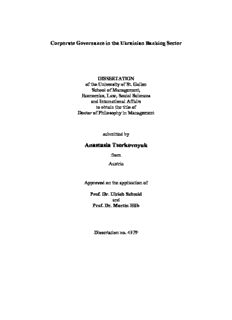
Anastasia Tserkovnyuk PDF
Preview Anastasia Tserkovnyuk
Corporate Governance in the Ukrainian Banking Sector DISSERTATION of the University of St. Gallen School of Management, Economics, Law, Social Sciences and International Affairs to obtain the title of Doctor of Philosophy in Management submitted by Anastasia Tserkovnyuk from Austria Approved on the application of Prof. Dr. Ulrich Schmid and Prof. Dr. Martin Hilb Dissertation no. 4379 The University of St. Gallen, School of Management, Economics, Law, Social Sciences and International Affairs hereby consents to the printing of the present dissertation, without hereby expressing any opinion on the views herein expressed. St. Gallen, October 22, 2014 The President: Prof. Dr. Thomas Bieger II ACKNOWLEDGMENTS First and foremost I would like to thank my advisors, Ulrich Schmid and Martin Hilb, for supporting me during the last few years. Their guidance helped me through the time of research and writing this thesis. I am thankful for their motivation, patience, constructive criticism and friendly advice during the project work. The PhD journey, was a long journey, with a lot of up’s and downs, therefore, I would like to express my gratitude to my friends who accompanied me through this chapter of my life. Selina Gartler, Hannes Tschütscher, Teresa Schoch, Carla Bayer, Birgit Fischer, Agnes Sprenger and Sonja Näscher - thank you for your support, your humor and your friendship. I am especially grateful to Agnes Sprenger for proofreading the manuscript. Last but not least, I would like to thank my wonderful parents Elena Romanova and Yuriy Tserkovnyuk for their unconditional love and encouragement during my whole life. From the bottom of my heart, I would like thank my boyfriend Franz Steinberger who was supporting me during the final stages of this PhD. III IV CONTENTS Contents ......................................................................................................................... V List of Figures ............................................................................................................... IX List of Tables ................................................................................................................. X List of Abbreviations .................................................................................................... XI Acknowledgments1. .......................................................................................................................... 1 1. INTRODUCTION ........................................................................................................ 1 1.1. Research Objectives .............................................................................................. 6 1.2. Definition of Key Terms ....................................................................................... 7 1.2.1. Corporate Governance ....................................................................................... 7 1.2.2. Banks ................................................................................................................. 9 1.2.3. The link between corporate governance and banks ........................................ 11 1.2.4. The link between corporate governance and transition economies ................ 12 1.3. Structure of the Study ......................................................................................... 15 2. RESEARCH DESIGN AND METHODS ...................................................................... 17 2.1. Research Design and Setting .............................................................................. 17 2.2. Sample ................................................................................................................ 17 2.3. Data Collection ................................................................................................... 18 2.4. Data Analysis Methods ....................................................................................... 21 2.5. External and Internal Validity ............................................................................ 22 V 3. ANALYSIS OF UKRAINIAN CORPORATE GOVERNANCE ENVIRONMENT ......................................................................................................... 23 3.1. Corporate Governance theories .......................................................................... 23 3.2. Corporate Governance Framework..................................................................... 27 3.3. Empirical analysis ............................................................................................... 31 3.3.1. Economic influences ....................................................................................... 31 3.3.1.1. Stage of transition ........................................................................................ 31 3.3.1.2. State of the economy .................................................................................... 34 3.3.1.3. Capital markets ............................................................................................ 37 3.3.1.4. Stock exchanges ........................................................................................... 39 3.3.1.5. Banking sector ............................................................................................. 42 3.3.1.6. Ukrainian regions ......................................................................................... 48 3.3.1.7. Education platforms ..................................................................................... 51 3.3.1.8. Economic implications for corporate governance ....................................... 53 3.3.2. Legal/political influences ................................................................................ 54 3.3.3. Social / cultural influences .............................................................................. 57 3.3.3.1. Cultural traditions ........................................................................................ 57 3.3.3.2. Ethical values ............................................................................................... 60 3.3.3.3. Institutions .................................................................................................... 61 3.3.3.4. The social/cultural environment’s implications for corporate governance . 63 3.3.4. Technological influences ................................................................................. 64 3.3.4.1. Transparency ................................................................................................ 64 3.3.4.2. Risk management ......................................................................................... 65 3.3.4.3. Technological environment’s implications for corporate governance ........ 66 3.4. Corporate Governance Environment conclusion ................................................ 67 VI 4. HOW DO BANK BOARDS REALLY WORK IN UKRAINE? ........................ 71 4.1. Hilb’s Integrated Corporate Governance Framework ........................................ 71 4.1.1. Board of Directors ........................................................................................... 73 4.1.2. The Board Structure ........................................................................................ 73 4.1.3. The Board Culture ........................................................................................... 79 4.1.4. Integrated Board Management ........................................................................ 81 4.2. Empirical Analysis .............................................................................................. 84 4.2.1. Board of Directors ........................................................................................... 84 4.2.2. The Board Structure ........................................................................................ 86 4.2.3. The Board culture ............................................................................................ 96 4.2.4. Integrated Board Management ...................................................................... 100 4.3. Conclusion ........................................................................................................ 104 5. DOES TRUST REALLY MATTER? .................................................................. 109 5.1. Trust Theory Overview ..................................................................................... 110 5.2. Empirical results ............................................................................................... 117 5.3. Conclusion ........................................................................................................ 127 VII 6. CONCLUSION .................................................................................................... 129 6.1. Current Corporate Governance and Future Challenges .................................... 129 6.2. The Ukrainian supervisory boards .................................................................... 130 6.3. Trust .................................................................................................................. 132 6.4. Limitations of the Research .............................................................................. 133 6.5. Suggestions for Future Research ...................................................................... 134 Appendices .................................................................................................................. 135 REFERENCES ........................................................................................................... 141 Note on the Author ...................................................................................................... 159 VIII LIST OF FIGURES Figure 1: An overview of the financial system ............................................................. 10 Figure 2: Corporate Governance framework ............................................................... 27 IX LIST OF TABLES Table 1: Population of the Research 1 ......................................................................... 19 Table 2: Population of the Research 2 ......................................................................... 21 Table 3: Overview of theories affecting corporate governance development .............. 23 Table 4: Benefits of Corporate Governance ................................................................. 25 Table 5: Effects of environmental variables on Stakeholder groups, and implications for theory ....................................................................................................................... 28 Table 6: Main macroeconomic indicators .................................................................... 35 Table 7: Bank indicators ............................................................................................... 44 Table 8: Concentration in the Ukrainian banking sector ............................................. 45 Table 9: Top-15 Ukrainian banks ................................................................................. 46 Table 10: IFC survey banks distribution ...................................................................... 50 Table 11: Key laws and regulations addressing corporate governance ...................... 54 Table 12: Differences between traditional and new corporate governance ................ 72 Table 13: Board cooperation rules ............................................................................... 80 Table 14: Contrasting requirements of board members ............................................... 81 Table 15: Common definitions of trust ....................................................................... 111 X
Description: